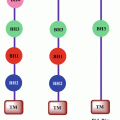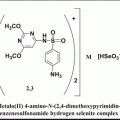Fig. 22.1
Medicinal plants used in traditional Korean medicine for cancer prevention and therapy
According to the theory of TKM, common causes that impede healthy living are an excess of mental, physical, and sexual activities; immoderate indulgence in outside pleasures lessens a person’s original life span. Life patterns should follow the change of seasons to nurture Yin and Yang in the human body. In the seasons of spring and summer, which belong to Yang, more active and outward mental and physical activities during daytime are encouraged, whereas in fall and winter, which belong to Yin, passive and inward activities are recommended. Following the circadian rhythms of day and night also helps preserve health.
Internal impairment due to the seven emotions (joy, anger, worry, pensiveness, sadness, fear, and fright) is considered as the fundamental and initial cause of many chronic diseases. Maintaining a good state of mind while regulating temperament and following a moral code is indispensable for nourishing life and for disease recovery. Continuous emotional turbulence can result in an imbalance of the entire body.
In the context of TKM, the human body consists of Yin and Yang. The material body, which belongs to Yin, is nourished by food from the earth, while the spirit, which belongs to Yang, is nourished by Qi from heaven. Relaxed, deep breathing from nose to lower abdomen (called “Dan-jeon”) is a life-nourishing technique for gathering Qi. Once the spirit becomes sound and healthy from accumulating Qi, the vital energy in the body springs from it. Traditional exercises combined with meditation are necessary to promote the flow of Qi and can slow the aging process. Swallowing saliva after tapping the teeth several times in the early morning is emphasized as one of important techniques for longevity. Although there are some differences, traditional exercise and meditation techniques are inherent to Qigong, Tai-chi, and meditation and are now encouraged by the medical field.
Geriatrics is embraced, with treatments providing supplemental medicinal plants or prescriptions for the weakened Yin and Yang of the elderly. Combinations of “superior medicinal plants,” which can help invigorate and replenish Qi and blood, are administered to the elderly persistently to rejuvenate the body and are generally considered very safe despite long-term use. Medicinal plants such as Rehmannia glutinosa, Polygonum multiflorum, and Cuscuta chinensis are frequently used for this purpose (Hur 1991).
Modern medicine has usually recognized disease as a thing of substance, while TKM has recognized disease with a phenomenalistic viewpoint. This implies that modern medicine analytically focuses on the disease itself, while TKM understands disease as one of the phenomena within a whole body. All symptoms and signs that can be detected by human senses are considered as the disease itself in TKM, and cancer can also be detected in various ways, in accordance with its appearance and character (Park 2002).
Jeok-chi, a type of disease in TKM, is closely linked to abdominal tumors accumulated over a long period. Jeok means immovable tumor and Chi means movable tumor. This can be related to malignant and benign, invasive and noninvasive, advanced, and early-stage tumors, respectively. Although Jeok-chi is a tangible disease, it originates from an intangible disorder of Qi. Stagnation of Qi induces stagnations in dampness, heat, phlegm, blood, and food consecutively. At the stage of stagnation of Qi, stagnation of dampness, or stagnation of heat, the tumor does not surface. However, at the phlegm, blood, and food stagnation stages, the tumor can be detected by human senses. The stagnation of Qi that accounts for tumor development can arise from various causes including external, internal, and environmental factors. Among these factors, TKM puts emphasis on internal factors such as emotions and physical inactivity. Among seven emotions, anger, worry, and pensiveness in particular cause stagnation of Qi, whereas joy, fear, fright, and sorrow do not cause stagnation of Qi (Hur 1991).
The stagnation of Qi can lead to diminished local blood circulation and can create localized hypoxic conditions that may promote inflammation and tumor growth. This traditional theory is consistent with recent studies. Red blood cell deformity that resists normal blood flow was found in small cell lung cancer patients as the principal determinant of capillary blood flow, which may result in decreased tumor oxygenation and decreased delivery of chemotherapeutic agents to the tumor tissue (Cohen 1981). Removing the pathologic products can make blood flow smoothly and can increase the local perfusion of oxygenated blood into tissues. The function of blood in carrying oxygen to tissues is directly related to the function of Qi.
Another disease name that relates to cancer is Ong-juh, which refers to all acute and chronic inflammation, including abscesses and carbuncles. Ong means acute inflammation and belongs among Yang symptoms, such as swelling, heating, and pain. Juh means chronic inflammation, which belongs among Yin symptoms rarely associated with swelling, heating, and pain. Various kinds of cancer and chronic inflammation are related to Ong-juh. Treatment strategies vary widely according to symptoms of Yin and Yang. Juh, a Yin symptom, exhibits poorer prognosis and more aggressive tumor development than Ong, a Yang symptom. The main cause of this disease is accumulated toxic substances in the human body, though it can also be influenced by Jeok-chi (Choi 1995; Hur 1991).
22.3 Cancer Prevention and Therapy in Traditional Korean Medicine
The philosophical strategy of TKM puts emphasis on holistic modulation and improvement of the whole body, rather than just removing tumors or killing cancer cells. It is the patient, not the tumor mass, that should be treated, pursuing the goal of extending life expectancy and improving quality of life. Most chronic diseases, including cancer, are caused by continuous imbalance of the network of body, mind, and spirit. The holistic approach is applicable in the broad spectrum of diagnosis, treatment, and prognosis in TKM.
The body’s internal condition plays a dominant role in cancer onset, meaning that exogenous pathogenic factors can induce cancer only when the body’s own defense system fails. According to TKM, chronic inflammation that cannot return to the normal state is mainly due to Qi deficiency. Invigorating Qi and expelling pathogenic factors are the fundamental therapies used in cancer prevention and treatment and are used alternately or concurrently according to the physical condition of the patient and the severity of the pathogen.
Most modern medicine therapies for cancer concentrate on expelling the pathogenic factor. This makes the patient weak and tired, which increases vulnerability to cancer recurrence due to immune system deficiency. On the other hand, TKM emphasizes the balance of Qi reinforcement and pathogen expulsion, so the clinical purpose is not complete tumor response but partial response or stable tumor disease while maintaining the body’s defenses. This is a more important strategy for a cancer patient with late-stage disease, whose Qi is lacking. Even during the early stage when aggressive therapy can be applied to expel the pathogen, TKM is very cautious not to cause further harm to Qi (Park and Moon 2008).
TKM insists that aggressive therapy for tumor inhibition should be applied to a halfway point and then stopped, because aggressive therapy weakens Qi, which could result in tumor recurrence. In turn, invigorating Qi therapy to activate the immune system also should reach a halfway point and be stopped, because extreme Qi invigoration can induce Qi stagnation, which can also lead to tumor recurrence (Hur 1991).
For the same cancer type in different persons, diagnosis and treatment schemes should be tailored according to their symptom pattern and constitution. The main categories for symptom pattern differentiation include: Yin and Yang, deficiency and excess, cold and hot, and superficial and deep. In detail, common trends in symptom patterns that manifest in many cancers include: stagnation of Qi and blood, phlegm and dampness accumulation, severe deficiency, and interior heat or heat-dampness. The symptom pattern differentiation also takes into consideration the differentiation of the four constitutions. Basically, an accurate symptom pattern differentiation, with individual characteristics such as constitution, can provide the most powerful tool for cancer prevention and therapy in TKM.
TKM suggests that if a person is diagnosed with a potentially fatal disease like cancer, the patient’s overall lifestyle should be modified to focus on restoring a healthy lifestyle, because it is difficult to treat cancer with only outside therapeutic modalities. The first step toward a healthy lifestyle is to step away from unhealthy concern over worldly affairs and seek peace via a mindset change. It is interesting to note that the approach used in psychosocial intervention in cancer is different between modern medicine and traditional medicine. Modern psychosocial interventions put emphasis on an active and positive attitude, with a “fighting spirit” toward cancer and life, in order to cope with disease. However, Eastern cultures and philosophies emphasize the importance of living with cancer while maintaining peace, balance, and harmony. If a patient focuses on winning the battle with cancer, of which the outcome is uncontrollable, it might result in a greater sense of loss for the patient. Instead, traditional intervention focuses on promoting a positive attitude toward care, treatment, and rehabilitation and helping patients accept the unpredictability of life, of cancer, of recurrence, or even death.
Using medicinal plants is one of the vital therapeutic modalities in TKM and requires detailed knowledge of the medicinal characteristics not only of each plant but also of the combined effects of individual components in formulations. Medicinal plant formulas, which usually consist of several plants, are chosen after careful diagnosis. Formulas are built through a metaphorical hierarchy-based TKM theory and are balanced to strengthen the intended effects and minimize any complications from individual plants.
Traditional medicine and its natural products have been rich and efficacious resources for new drug discovery. TKM-based medicinal plants, which have been used in cancer treatment for more than 2,000 years, are now gaining further attention as their anticancer mechanisms and targets are revealed. The administration of multiple low-dose pharmaceutical agents synergistically is in complete contrast to modern medicine, which typically focuses on a high-dose effect of a single pharmaceutical agent. To treat cancer, various kinds of herbs with different capacities to boost Qi, remove blood stagnation, clear damp/phlegm and toxin, and inhibit tumor growth are mixed in a formula. Natural medicinal plants that have been used to treat Jeok-chi or Ong-juh, such as Rhus verniciflua, Allium sativum, Corydalis turtschaninovii, Curcuma longa, Curcuma zedoaria, Sparganium stoloniferum, Boswellia carteri, and Ferula assafoetida, have been studied extensively for their anticancer effects (Table 22.1).
Table 22.1
Medicinal plants commonly used in traditional Korean medicine for cancer prevention and treatment
Category of usage | Common name (Scientific name) | Active components |
|---|---|---|
Invigorating Qi | Astragalus root (Astragalus membranaceus) | Astragalus saponins |
Ginseng (Panax ginseng) | Dehydroebriconic acid, ginsenoside-Rg1, panaxydol | |
Jujube fruit (Zizyphi fructus) | Protojujubosides A, jujubosides A, B, and C | |
Siberian Ginseng (Acanthopanax sessiliflorum) | Anthocyanin | |
Caterpillar fungus (Cordyceps sinensis) | Tanshinone IIA | |
Plum (Prunus mume) | Neochlorogenic acid, CGA, CCGA | |
Sanghwang mushroom (Phellinus linteus) | Hispolon | |
Removing blood stagnation | Red sage (Salvia miltiorrhiza) | Water extract |
Leguminosae (Spatholobus suberectus) | Dihydroquercetin, butin, dihydrokaempferol | |
Mistletoe (Viscum album) | Viscotoxin, lectin | |
Honeyweed (Leonurus sibiricus) | Organic extract | |
Spikemoss (Selaginella tamariscina) | Isocryptomerin, 2′,8″-biapigenin | |
Damp/phlegm clearance | Wolfiporia extensa (Poria cocos)
Stay updated, free articles. Join our Telegram channel
Full access? Get Clinical Tree
 Get Clinical Tree app for offline access
Get Clinical Tree app for offline access

|





